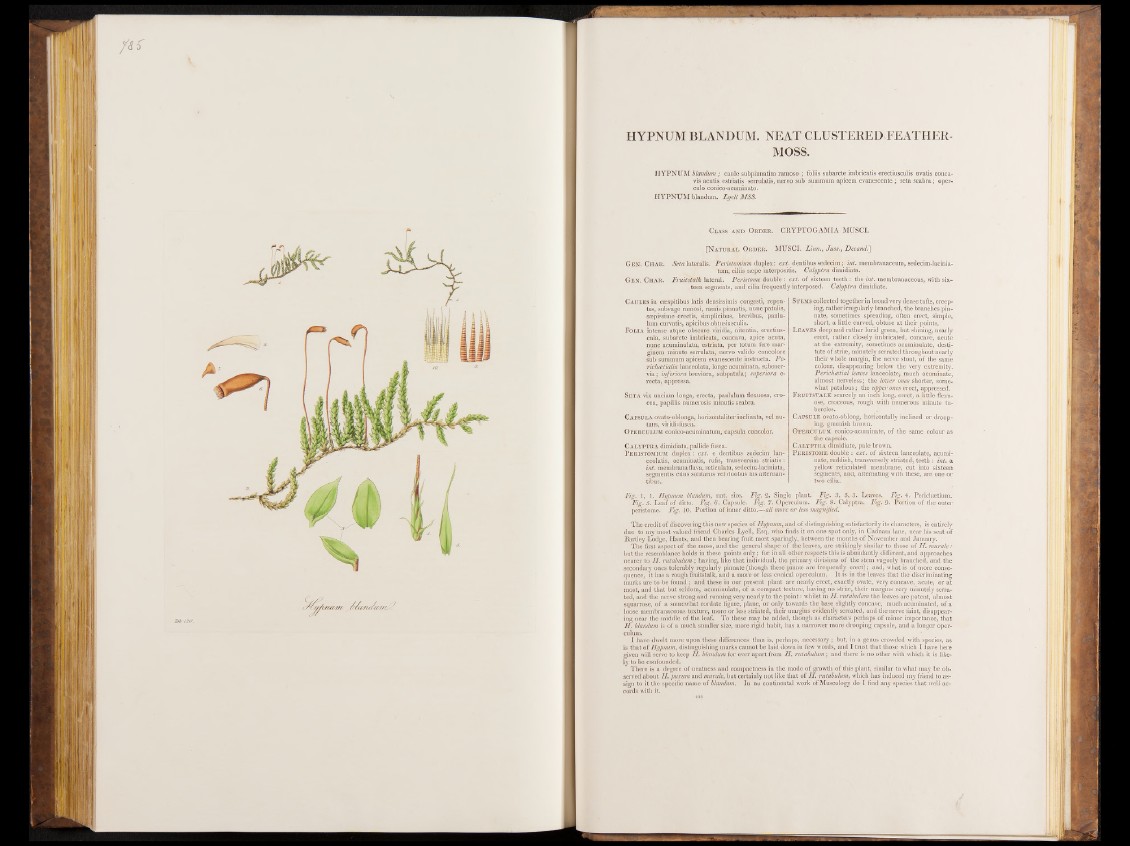
it I f t [ I t 11 M ill fillITlw-
HYPNUM BLANDUM. NEAT CLUSTERED FEATHER-
MOSS.
H Y PN UM blandum ; caule subpinnatim ramoso ; foliis subarcte imbricatis erectiusculis ovatis conca-
vis acutis estriatis serrulatis, nervo sub summum apicem evanescente ; seta scabra ; oper-
culo conico-acuminato.
H Y PN UM blandum. Lyell M SS.
Class and Order. C RYPTOGAMIA MUSCI.
[N atural Order. MUSCI. Linn., Suss., Decand.]
Ge n . Ch a r . Seta lateralis. Peristomium duplex: ext. dentibussedecim; int. membranaceum, sedecim-lacinia-
tum, ciliis stepe interpositis. Calyptra dimidiata.
Ge n . Ch a r . Fruitstalk lateral. Peristome double : ext. o f sixteen te e th : the int. membranaceous, with sixteen
segments, and cilia frequently interposed. Calyptra dimidiate.
Caules in cæspitibus latis densissimis congesti, repentes,
subvage ramosi, ramis pinnatis, nunc patulis,
sæpissime erectis, simplicibus, brevibus, paulu-
lum curvatis, apicibus obtusiusculis.
Folia intense atque obscure viridia, nitentia, erectius-
cula, subarcte imbricata, concava, apice acuta,
nunc acuminulata, estriata, per totum fere mar-
ginem minute serrulata, nervo valido concolore
sub summum apicem evanescente instructa. Pe-
richætialia lanceolata, longe acuminata, subener-
via ; inferiora breviora, subpatula ; superiora e-
recta, appressa.
Seta vix unciam longa, erecta, paululum flexuosa, cro-
cea, papillis numerosis minutis scabra.
Capsula ovato-oblonga, horizontaliter inclinata, vel nutans,
viridi-fusca.
Operculum conico-acuminatum, capsula concolor.
Calyptra dimidiata, pallide fusca.
Peristomium duplex : ext. e dentibus sedecim lan-
ceolatis, acuminatis, rufis, transversim striatis :
int. membrana flava, reticulata, sedecira-laciniata,
segmentis ciliis solitariis vel duobus his alternan-
tibus.
Stems collected together in broad very dense tufts, creeping,
rather irregularly branched, the branches pinnate,
sometimes spreading, often erect, simple,
short, a little curved, obtuse at their points;
Leaves deep and rather lurid green, but shining, nearly
erect, rather' closely imbricated, concave, acute
at the extremity, sometimes acuminulate, destitute
of striee, minutely serrated throughout nearly
their whole margin, the nerve stout, of the same
colour, disappearing below the very extremity.
Perichcetial leaves lanceolate, much acuminate,
almost nerveless; the lower ones shorter, somewhat
patulous; the upper ones erect, appressed.
Fruitstalk scarcely an inch long, erect, a little flexh-
ose, croceous, rough with numerous minute tubercles.
Capsule ovato-oblong, horizontally inclined or droop-
ing, greenish brown.
Operculum conico-acuminate, of the same colour as
the capsule.
Calyptra dimidiate, pale brown.
Peristome double : ext. of sixteen lanceolate, acuminate,
reddish, transversely striated, teeth : int. a
yellow reticulated membrane, cut into sixteen
segments, and, alternating with these, are one or
Fig. 1, 1. Hypnum blandum, nat. size. Fig. 2. Single plant. Fig. 3, 3 ,3 . Leaves. Fig. 4. Perichostium.
Fig. 5. Leaf of ditto. Fig. 6. Capsule. Fig. 7. Operculum. Fig. 8. Calyptra. Fig. 9- Portion of the outer
peristome. Fig. 10. Portion of inner ditto.— all more or less magnified.
The credit of discovering this new species o f Hypnum, and of distinguishing satisfactorily its characters, is entirely
due to my most valued friend Charles Lyell, Esq. who finds it on one spot only, in Cadnam lane, near his seat o f
Bartley Lodge, Hants, and then bearing fruit most sparingly, between the months of N ovember and January.
The first aspect of the moss, and the general shape of the leaves, are strikingly similar to those of H . murale:
but the resemblance holds in these points only; for in all other respects this is abundantly different, and approaches
nearer to H . rutabulum ; having, like that individual, the primary divisions of the stem vaguely branched, and the
secondary ones tolerably regularly pinnate (though these' pinnte are frequently erect); and, what is of more consequence,
it has a rough fruitstalk, and a more or less conical operculum. I t is in the leaves that the discriminating
marks are to be found ; and these in our present plant are nearly erect, exactly ovate, very concave, acute, or at
most, and that but seldom, acuminulate, of a compact texture, having no strife, their margins very minutely serrated,
and the nerve strong and running very nearly to the point: whilst in H. rutabulum the leaves are patent, almost
squarrose, of a somewhat cordate figure, plane, or only towards the base slightly concave, much acuminated, of a
loose membranaceous texture, more or less striated, their margins evidently serrated, and the nerve faint, disappearing
near the middle of the leaf. To these may be added, though as characters perhaps of minor importance, that
H . blandum is of a much smaller size, more rigid habit, has a narrower more drooping capsule, and a longer operculum.
I have dwelt more upon these differences than is, perhaps, necessary; but, in a genus crowded with species, as
is that of Hypnum, distinguishing marks cannot be laid down in few words, and I trust that those which I have here
given will serve to keep H . blandum for ever apart from II. rutabulum; and there is no other with which it is likely
to be confounded.
There is a degree of neatness and compactness in the mode of growth of this plant, similar to what may be observed
about II. purum and murale, but certainly not like that of I I . rutabulum, Which has induced my friend to assign
to it the specific name of blandum. In no continental work of Muscology do I find any species that well ac